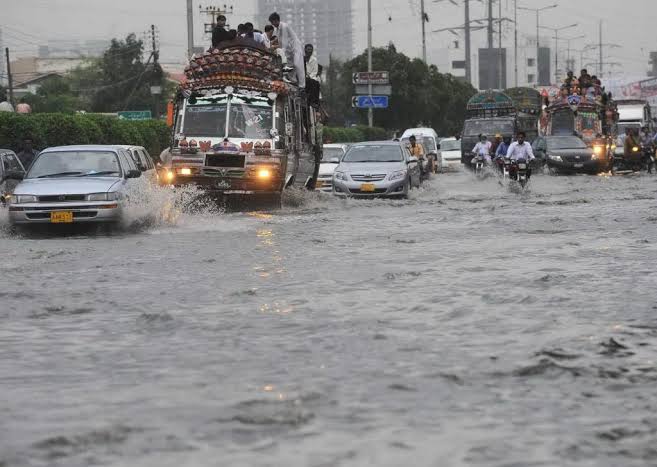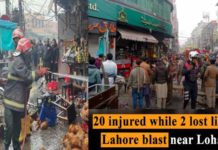Heavy rains on August 26 in different parts of Karachi, the capital of Sindh province, did not subside on the same day, and videos of the resulting urban flooding and damage to lives and property are still viral on local media and social networking sites.
Most of you would have seen the video of this street in Orangi Town which turned into a sewer after heavy rain. The flow of rain water must have made you feel that this is actually the place where the drain flows and citizens have built their homes around it.
Or the video in which volunteers from the welfare organization Al-Khidmat Foundation are seen rescuing schoolgirls from a flood-prone area to a safe place. There are numerous video clips circulating on social media where destruction of expensive cars and valuables inside homes can be seen.
The political point scoring that surfaced after the videos went viral shall be discussed later. First it is important to see how much rain was recorded in Karachi? How the urban flooding situation arose? And what would have happened if it had rained so much in any other city of the country?
How much it rained in Karachi?
If you look at the archives of the Pakistan Meteorological Department, the highest rainfall in the whole month of July was recorded in 1967, which amounted to 429.3 mm. The Meteorological Department is silent on the situation which took place in the city after this disaster. The average annual rainfall in Karachi is about 174.6 mm.
The amount of rain that caused the urban flooding situation in Karachi on July 26 was different in different parts of the city. According to the data provided by the Meteorological Department, the highest rainfall of 86 mm was recorded in the areas adjacent to Gulshan-e-Hadid, 81 mm on University Road, 73 mm in Surjani Town and 58 mm in Jinnah town. 51 mm of rain was recorded in Kemari, 62 mm in North Karachi, and 51 mm in Saddar and 28 mm in Nazimabad. On July 27 (Monday), Nazimabad received 34 mm of rain, Gulistan-e-Jauhar 10 mm, North Karachi 8 mm and Pahlawan Goth 2 mm of rain.
Asifa Bhutto Zardari says that the average annual rainfall in Karachi is 174.6 mm while the city has received a total of 153 mm of rainfall during the last 40 hours (about two days), which is 90% of the average annual rainfall.
A meeting was held under the chairmanship of Sindh Chief Minister Syed Murad Ali Shah on Tuesday morning due to the monsoon situation. On the occasion, the Local Government Minister said that the city’s main roads were drained as soon as the rains stopped, while drains were blocked in some places, causing some problems.
However, the Chief Minister may not have been very satisfied with this response and said that cleaning the drains alone is not the solution to the problem. “Buildings have been erected on the natural waterways and there are encroachments which prevent water from flowing out,” he said, adding that regular planning instructions have been issued in this regard.
Meteorologist expert Dr. Shehzada Adnan says that in a few hours, 86 mm of rain in a large and densely populated city of Pakistan is more than normal, and it is not so much that most areas of the city could face flood like situation.
He said that if it had rained so much in Islamabad, water would not have been visible in any area within half an hour. If we talk about densely populated Rawalpindi, due to many factors, such a large amount of rain there would have created a situation of urban flooding at a few places, but maybe only for an hour or two. And that’s because these cities have better drainage systems. The situation in Karachi is due to the drainage system where even a little rain causes havoc.
Why does Karachi Drown Even in Normal Rain?
There are about 44 major drainage canals in Karachi, of which Gujjar drain, Orangi drain and Mahmoodabad drain are 8 to 12 km long, and these are the drains that cause more difficulties for the people of Karachi. In addition, there are about 550 small rainwater drains managed by the Karachi Municipal Corporation and DMCs.
NED University Professor Noman Ahmed says that the capacity of the drainage system in Karachi has been reduced due to accumulation of salt and solid waste and lack of proper and timely management of sanitation.
High Level of Roads
According to Prof. Noman Ahmed, the feeders are also ensured to work as per their capacity so that as soon as water comes on the road, it is drained immediately.
In the old city of Karachi, there was a system where even if it rained continuously for an hour or two, the water would be drained, but the roads that have been built in the recent past are not connected to the local drainage system. The matter was not taken care of.
He said that this is the reason why these local drains are not able to drain water as per their capacity and this water enters the urban population.
Occupancy of Drains and Lands
Karachi urban planning expert architect Marvi Mazhar says the urban mafia is also responsible for the urban flooding, which is the case in poor communities where houses are built by occupying the canal corridors. Nobody dares question them. The Lyari River is the city’s main drainage system, and proposals are now being drawn up in the name of the Green Belt. Prof. Noman Ahmed said that as soon as it rained, water used to reach the sea through these canals.
Professor Noman says many private housing schemes are forcibly diverting natural flows of water, with the result that water flows into settlements and last year caused superhighways to collapse due to the same water.
Politics on Urban Flooding
Political representation in Karachi consists of three different segments. Karachi Municipal Nazim Wasim Akhtar belongs to the MQM. With 14 National Assembly seats, the PTI is the largest party in the city, with a federal government. In Karachi, the PPP has two seats in the National Assembly and runs the affairs of the provincial government. Political tensions between the three parties have been simmering for the past several years and whenever there is a public issue, it is well politicized.
This is not possible if it rains and there is no politics. While Pakistan Tehreek-e-Insaf (PTI) ministers, advisers and parliamentarians have blamed the current ruling party in Sindh, the Pakistan People’s Party (PPP), for the situation caused by the recent rains, the PPP has apparently turned a blind eye to the issue and has labeled it a propaganda against PPP government.
However, whether it is the video of Orangi Town or the videos of damage to public property, PPP are not talking about it and no explanation is being offered.
Education Minister Sindh, Saeed Ghani retweeted a tweet by a citizen, “The media has created an atmosphere where it seems that if it rains, it only rains in Sindh. Corona spreads only in Sindh. There is bad governance.” So it is only in Sindh, if hunger and poverty is increasing, it is only increasing in Sindh, such fake tactics fuel provincialism, and increase hatred”.
Ali Haider Zaidi, a PTI member from Karachi and a member of the National Assembly and Federal Minister, while sharing the Orangi video, wrote, “Sindh government, any shame?”
He further said that after reviewing the attitude and performance of the PPP government in Sindh (especially with regard to Karachi), I have come to the conclusion that the PPP has destroyed the city and Pakistan economically. The damage has been done for years. The PPP has returned to us without remorse for decades.
However, after looking at all these tweets and political point scoring it is evident that Karachi appears to be an orphan. No one from the provincial government or the federal cabinet is ready to take the blame. The people of Karachi are on their own, the financial center of the country only stands its ground to be looted from every corner. It’s high time that the people must press the protest button and hit the streets for their rights. No prince or peer will appear, it’s their battle and they must fight even with tears.








